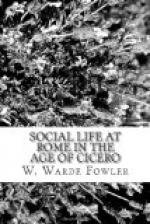But we must now turn to the real ludi, organised by the State on a large and ever increasing scale. The oldest and most imposing of these were the Ludi Romani or Magni, lasting from September 5 to September 19 in Cicero’s time. These had their origin in the return of a victorious army at the end of the season of war, when king or consul had to carry out the vows he had made when entering on his campaign. The usual form of the vow was to entertain the people on his return, in honour of Jupiter, and thus they were originally called ludi votivi, before they were incorporated as a regularly recurring festival. After they became regular and annual, any entertainment vowed by a general had to take place on other days; thus in the year 70 B.C. Pompey’s triumphal ludi votivi immediately preceded the Ludi Romani of that year,[466] giving the people in all some thirty days of holiday. The centre-point, and original day, of the Ludi Romani was the Ides (13th) of September, which was also the day of the epulum Jovis,[467] and the dies natalis (dedication day) of the Capitoline temple of Jupiter; and the whole ceremonial was closely connected with that temple and its great deity. The triumphal procession passed along the Sacra via to the Capitol, and thence again to the Circus Maximus, where the ludi were held. The show must have been most imposing; first marched the boys and youths, on foot and on horseback, then the chariots and charioteers about to take part in the racing, with crowds of dancers and flute-players,[468] and lastly the images of the Capitoline deities themselves, carried on fercula (biers). All such shows and processions were dear to the Roman people, and this seems to have become a permanent feature of the Ludi Romani, whether or no an actual triumph was to be celebrated, and also of some other ludi, e.g. the Apollinares and the Megalenses.[469] Thus the idea was kept up that the greatness and prosperity of Rome were especially due to Jupiter Optimus Maximus, who, since the days of the Tarquinii, had looked down on his people from his temple on the Capitol.[470]
The Ludi Plebeii in November seem to have been a kind of plebeian duplicate of the Ludi Romani. As fully developed at the end of the Republic, they lasted from the 4th to the 17th; their centre-point and original day was the Ides (13th), on which, as on September 13, there was an epulum Jovis in the Capitol.[471] They are connected with the name of that Flaminius who built the circus Flaminius in the Campus Martius in 220 B.C., the champion of popular rights, killed soon afterwards at Trasimene; and it is probable that his object in erecting this new place of entertainment was to provide a convenient building free of aristocratic associations. But unfortunately we know very little of the history of these ludi.




